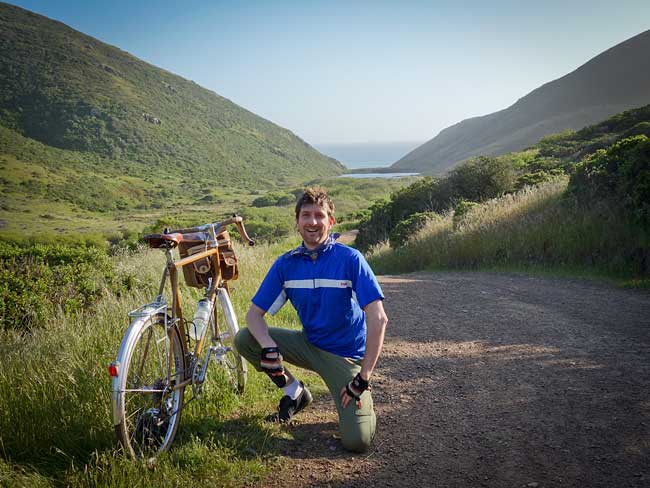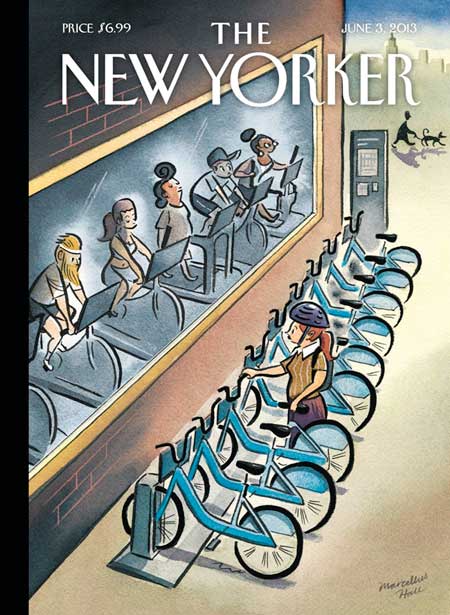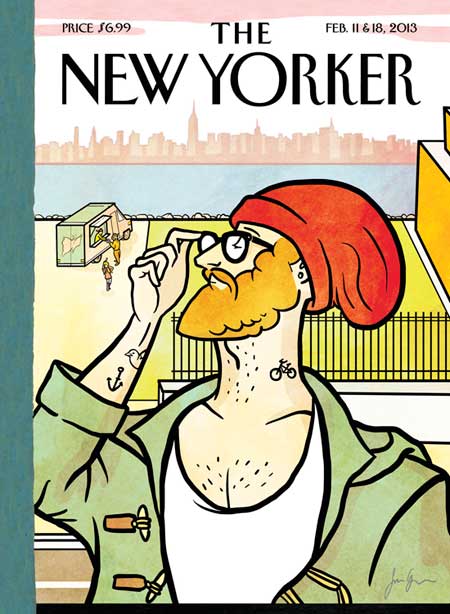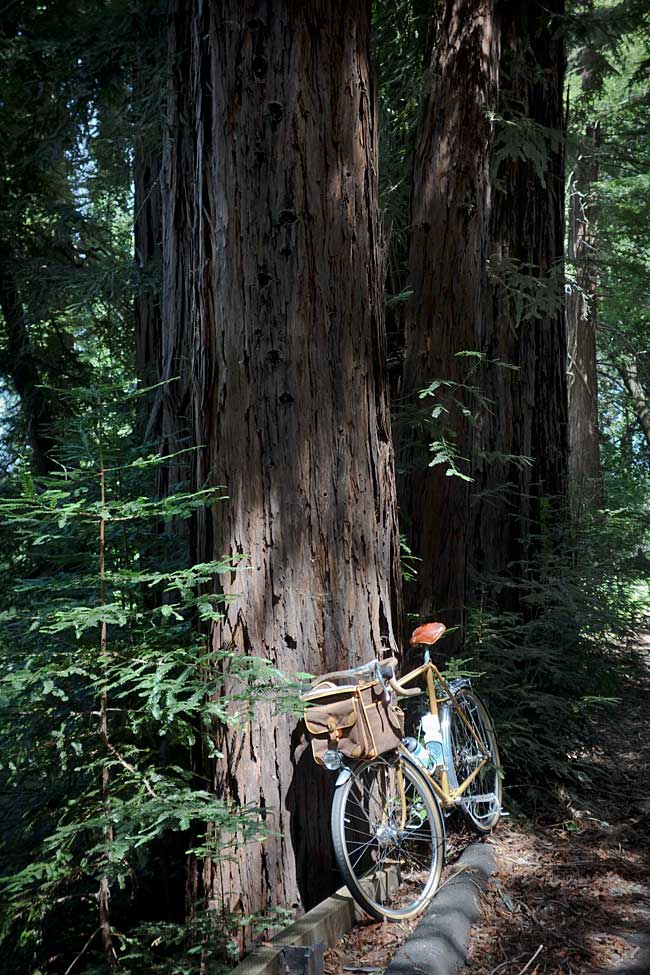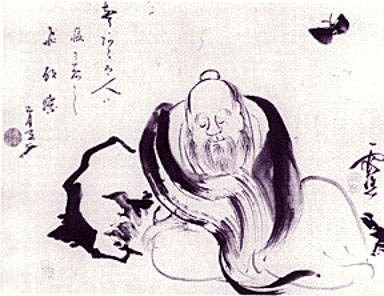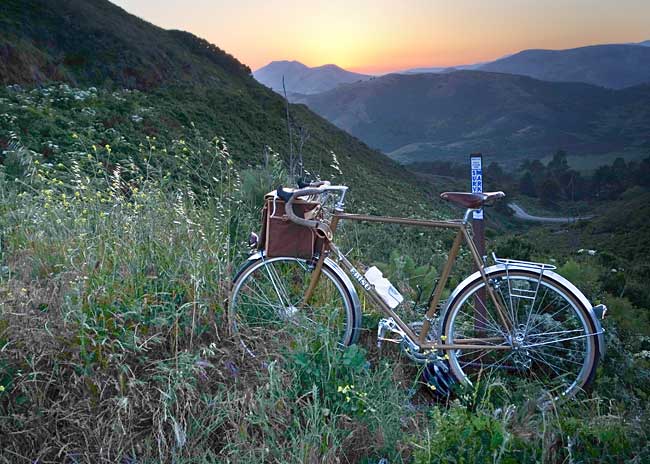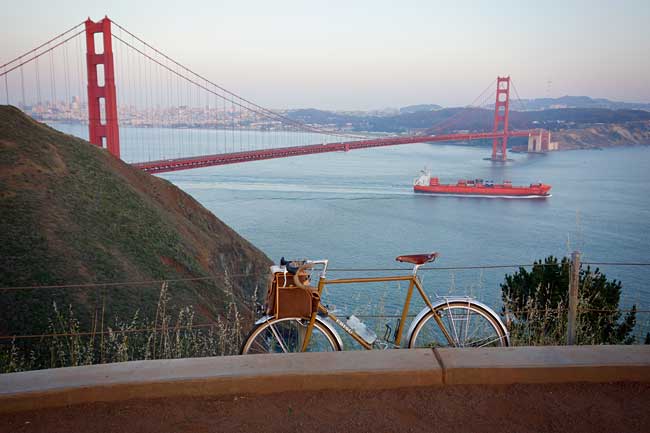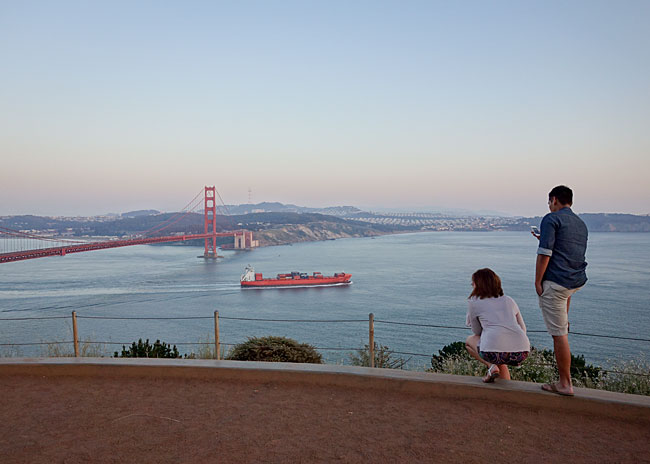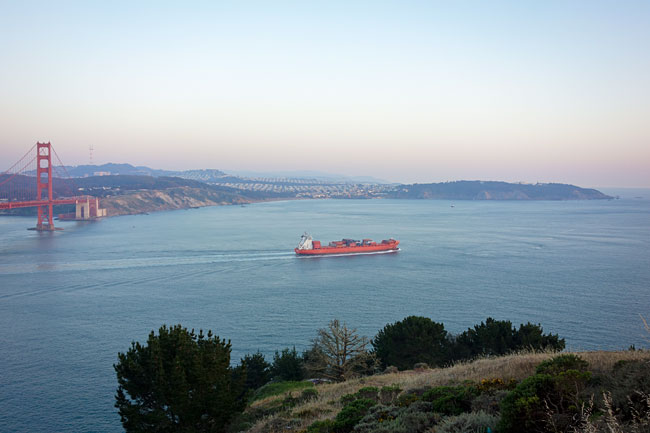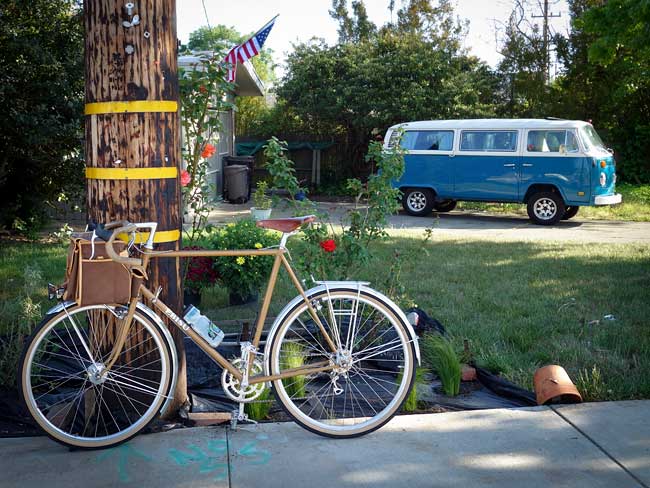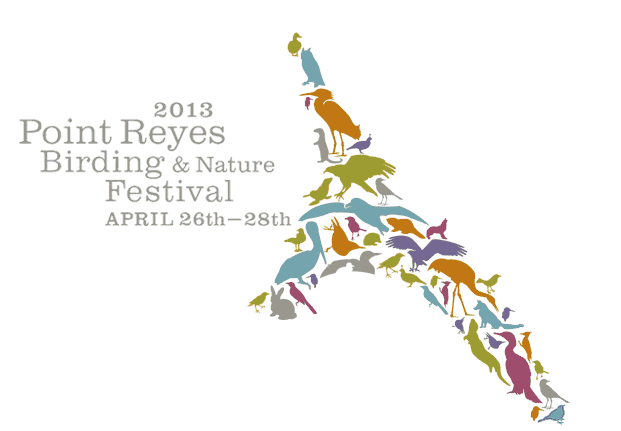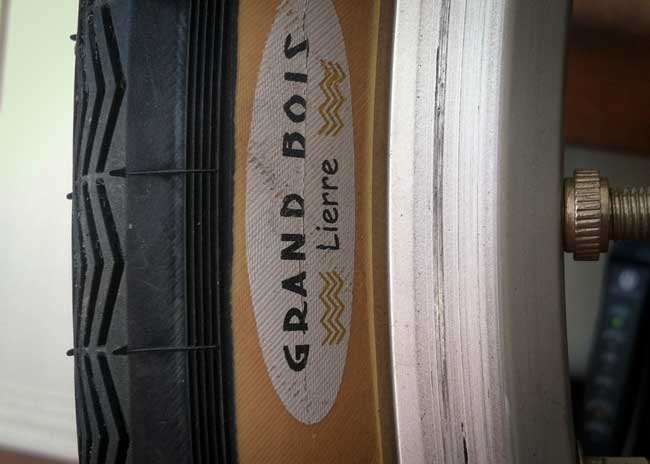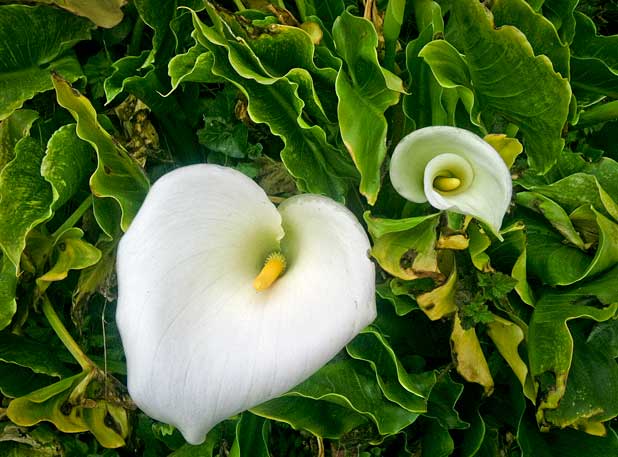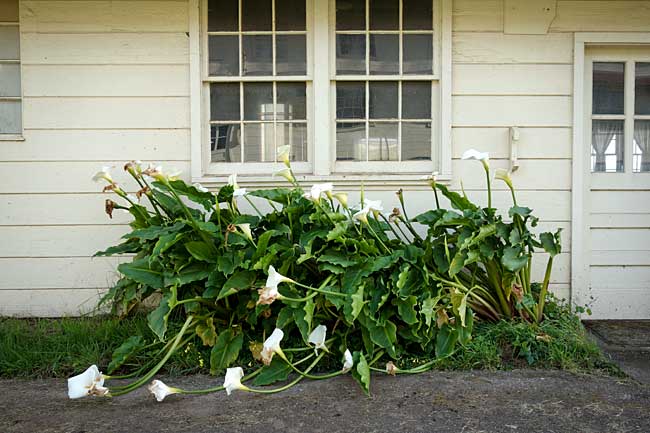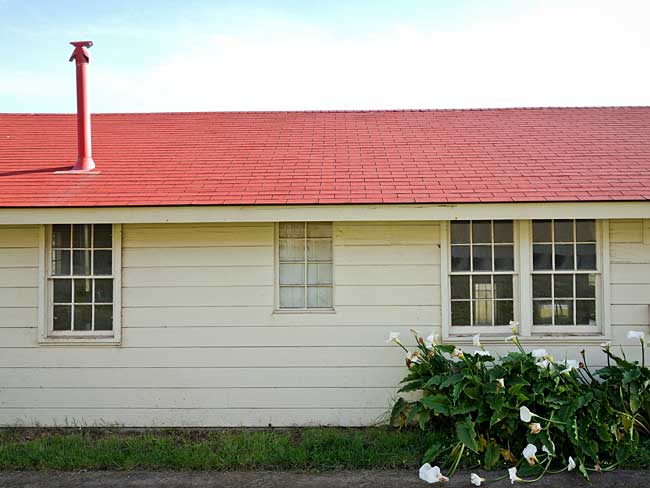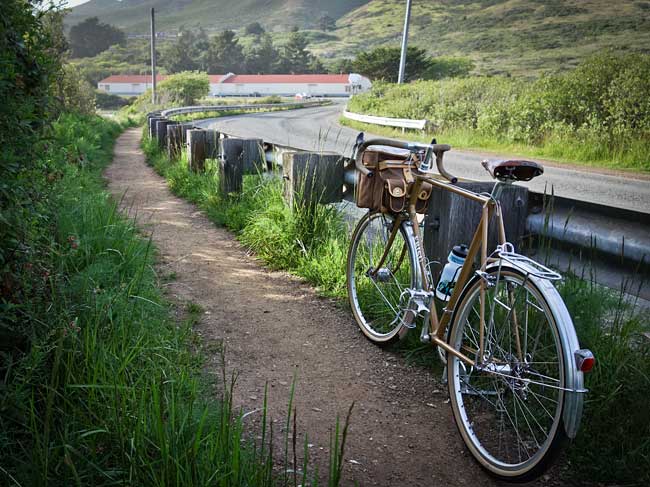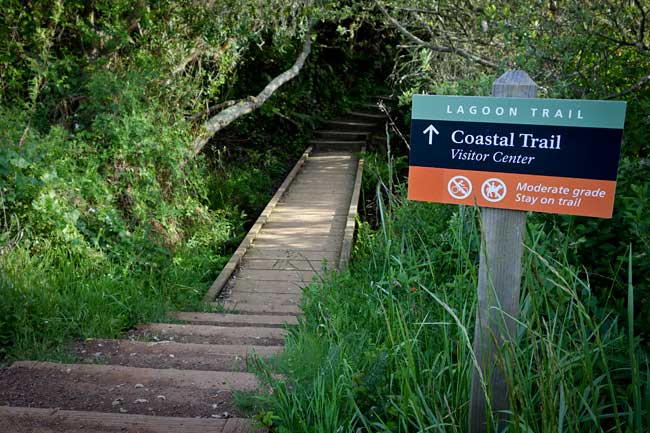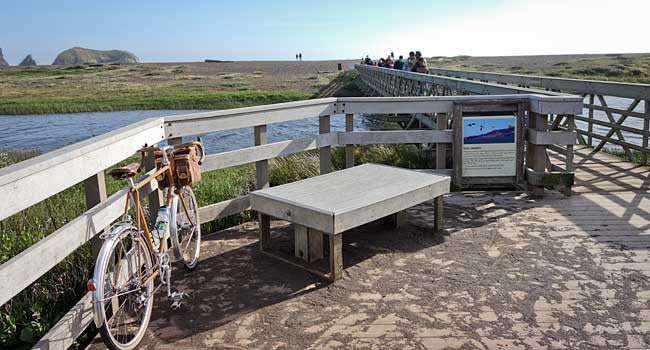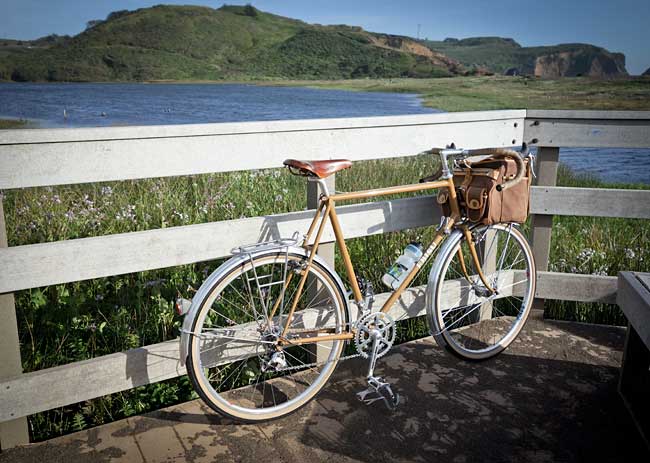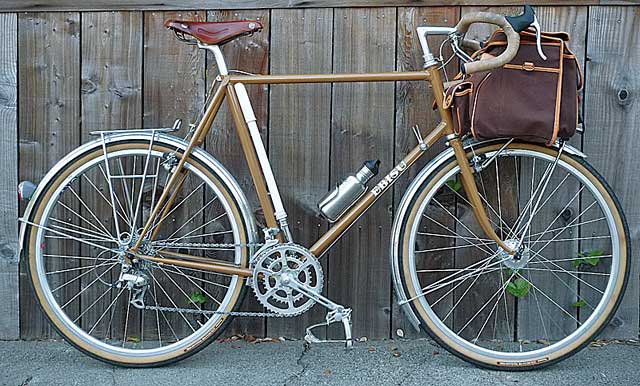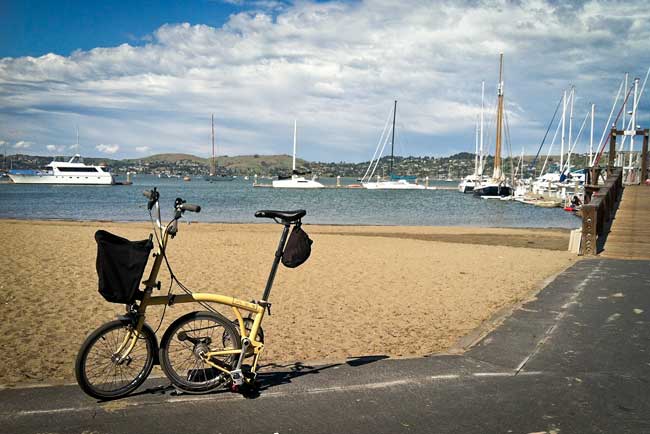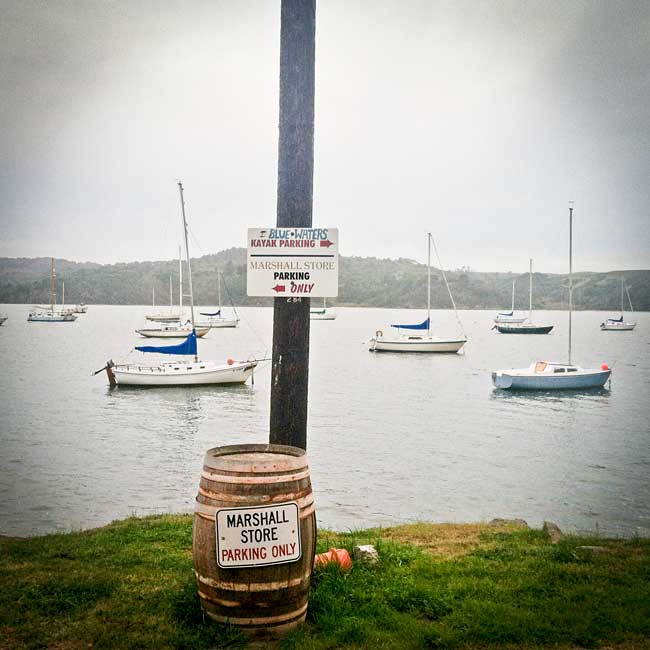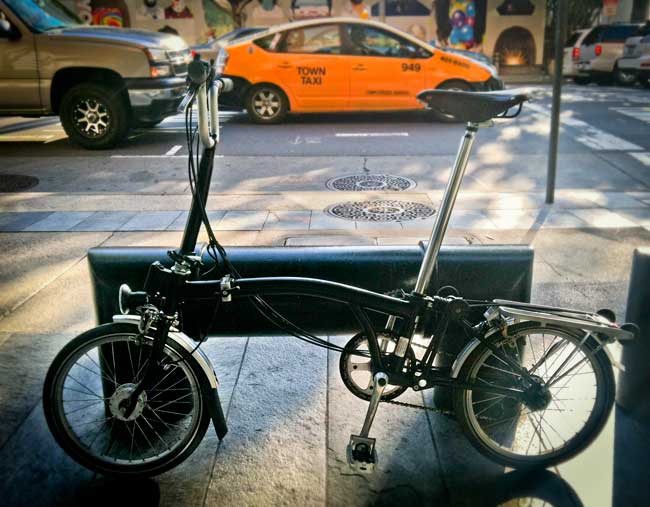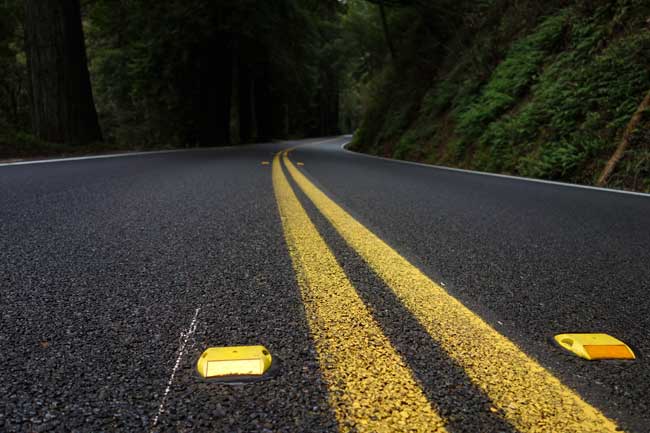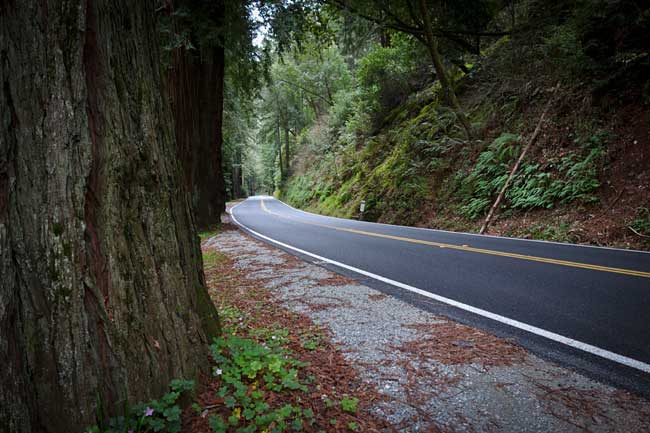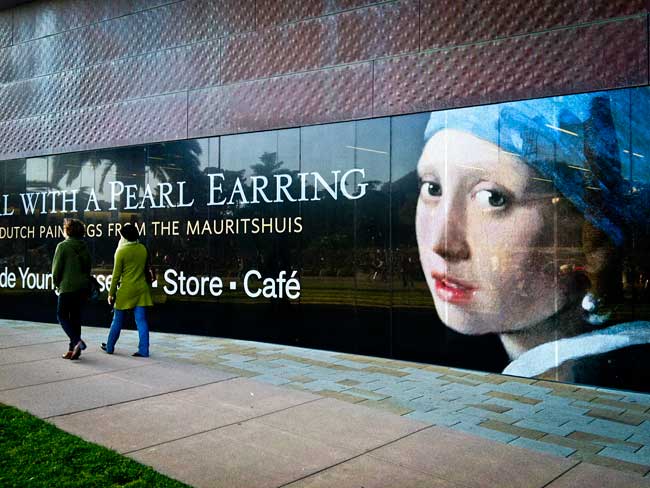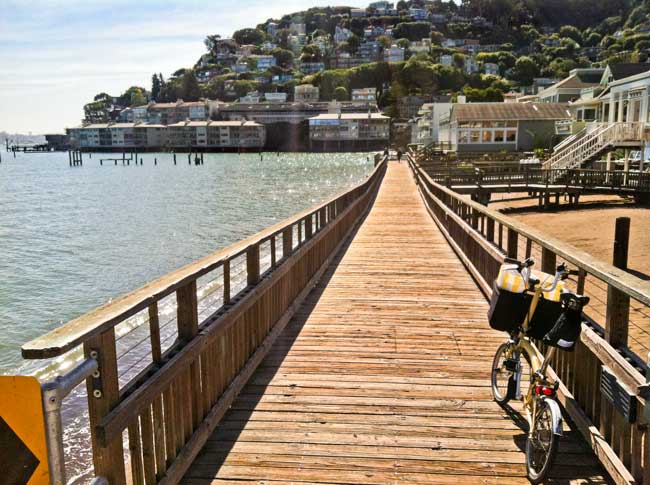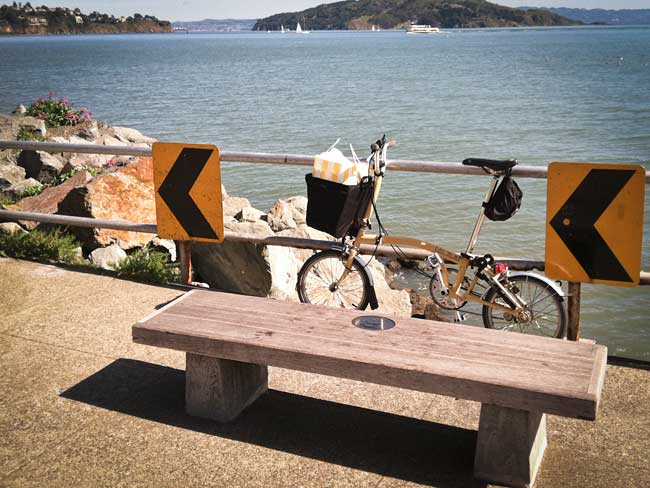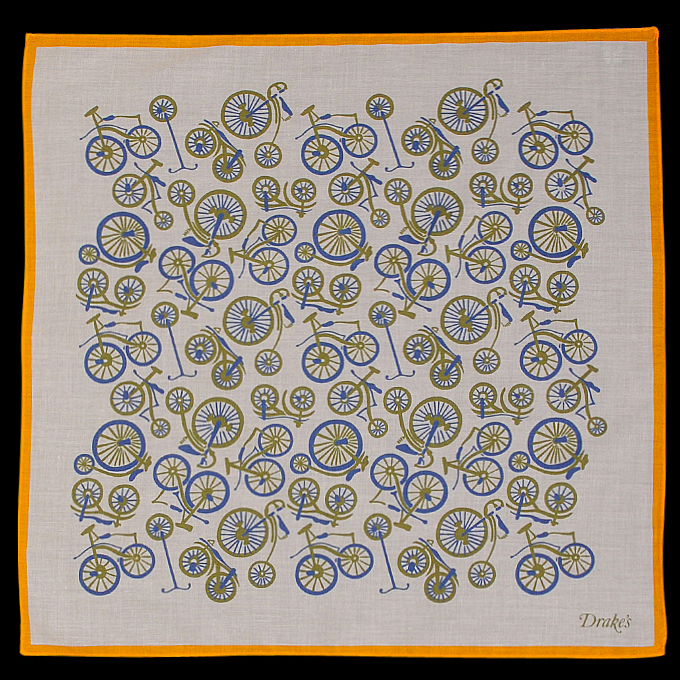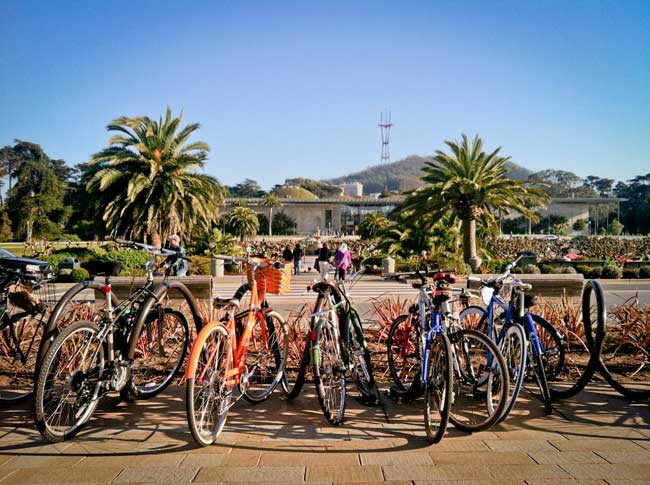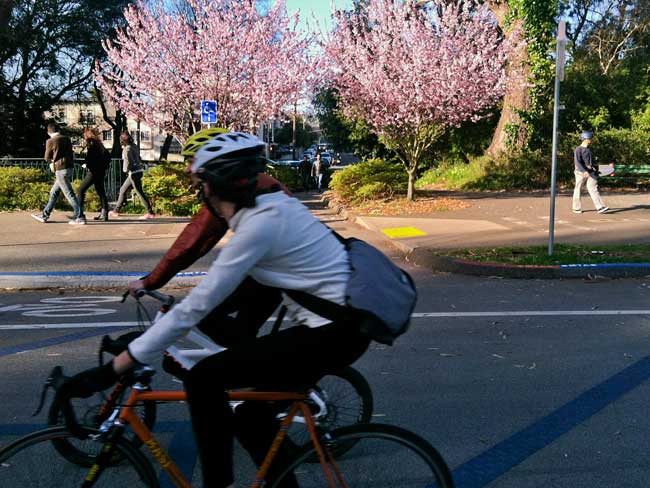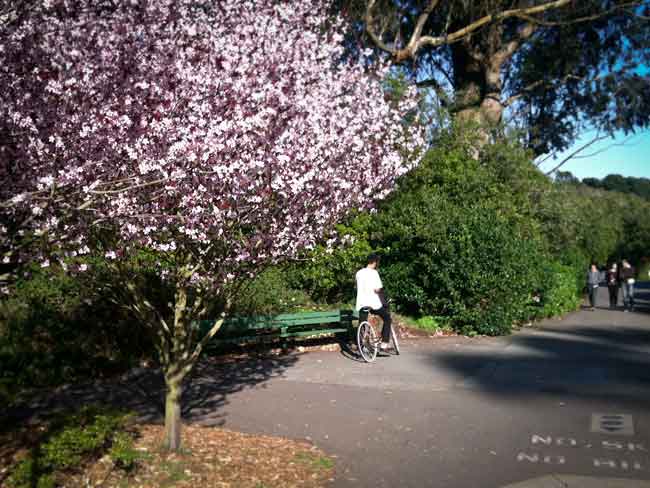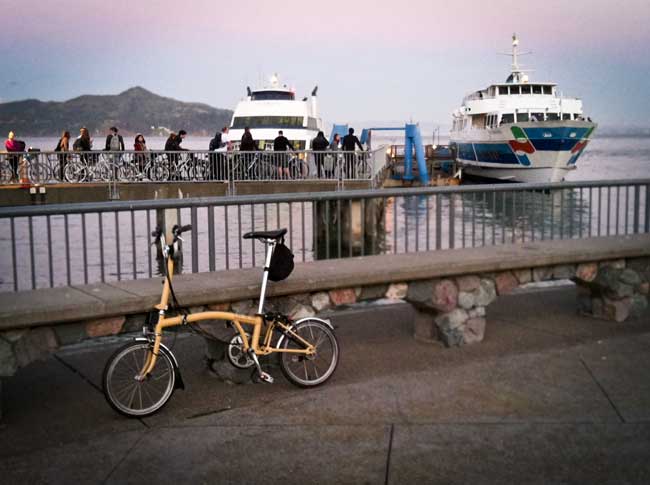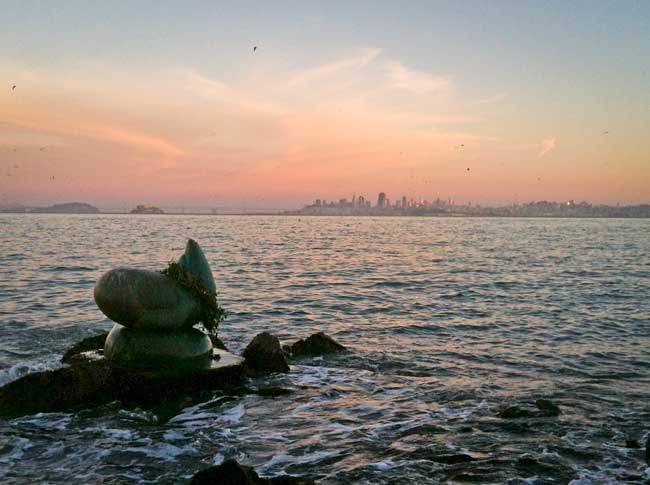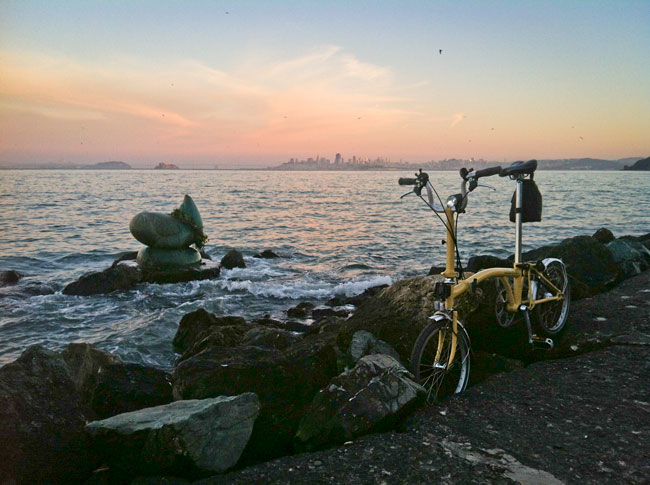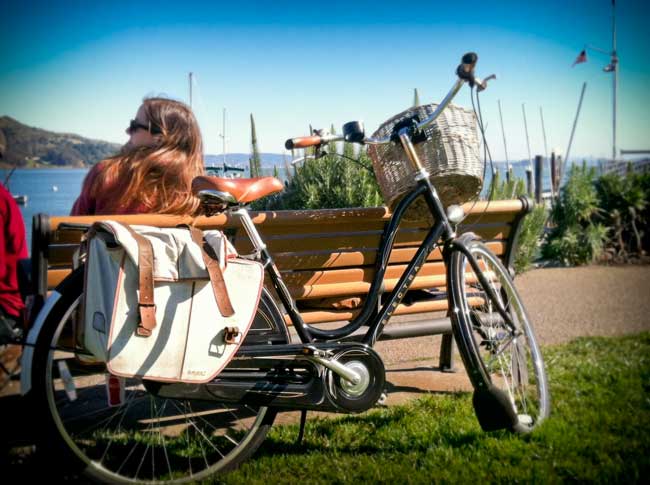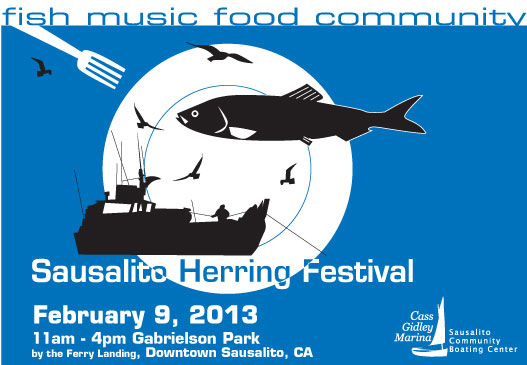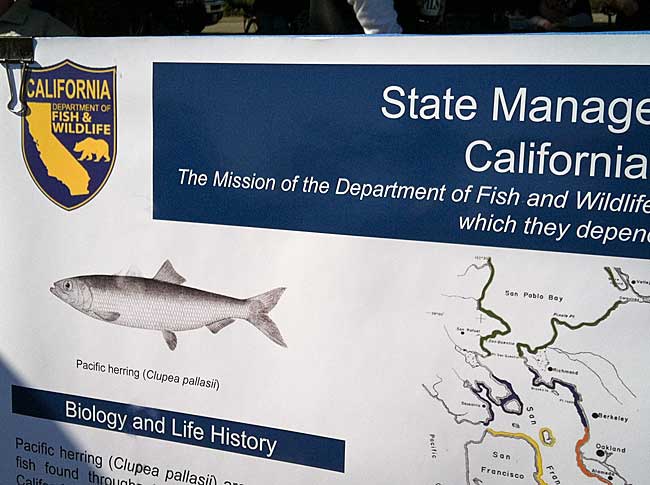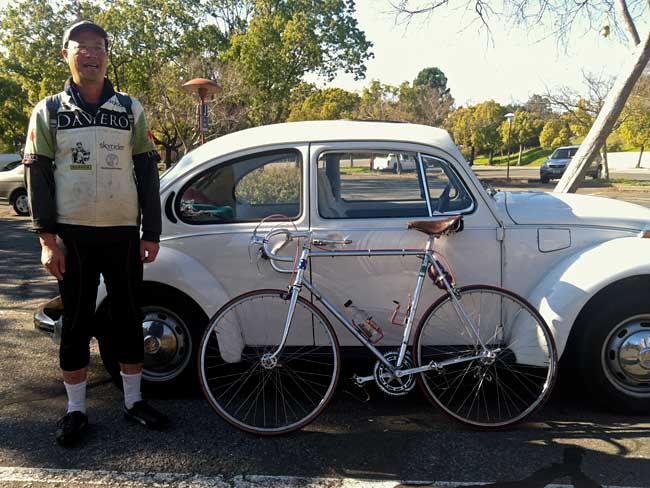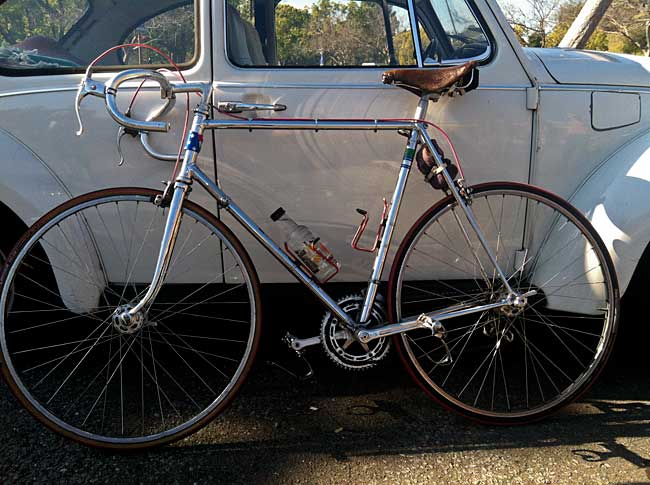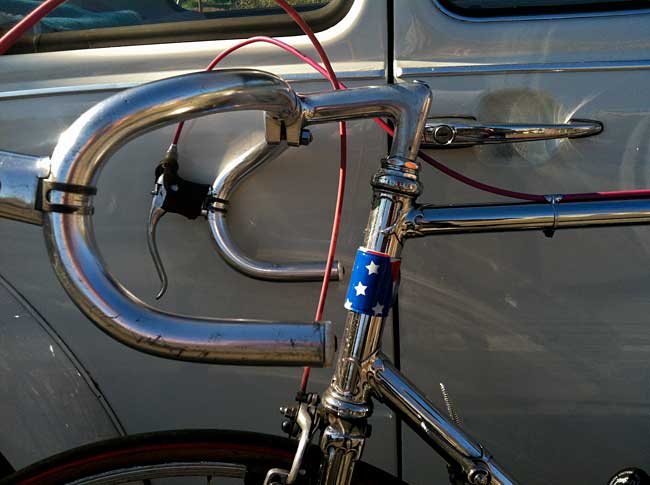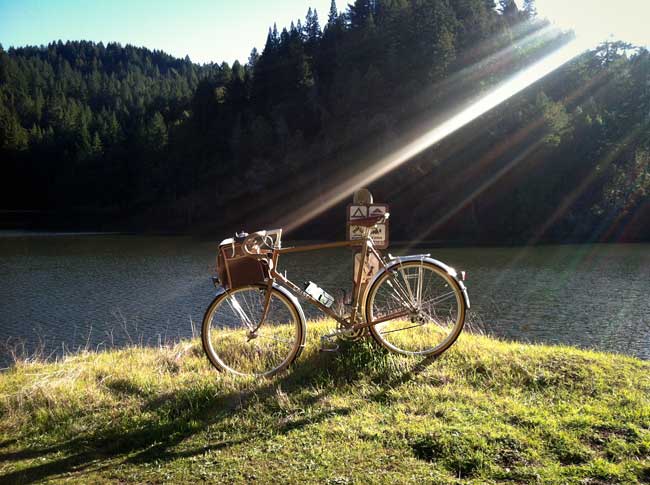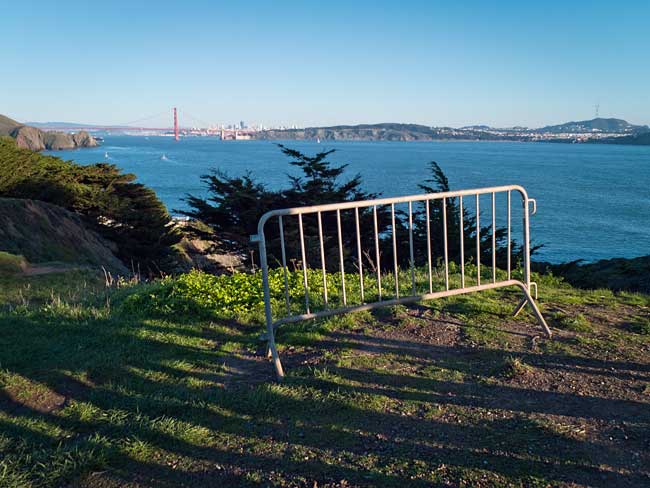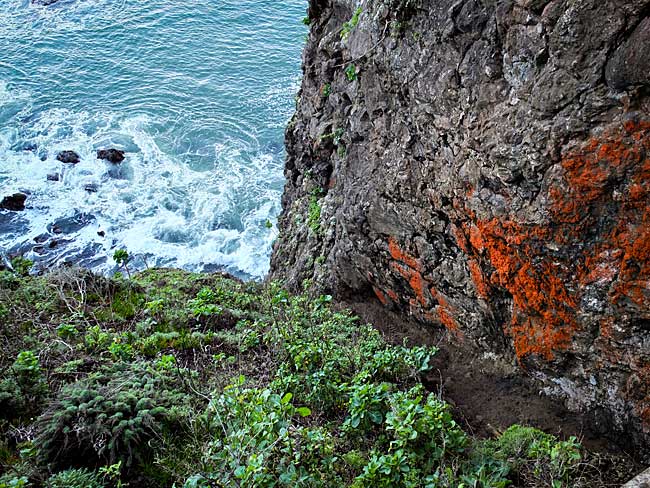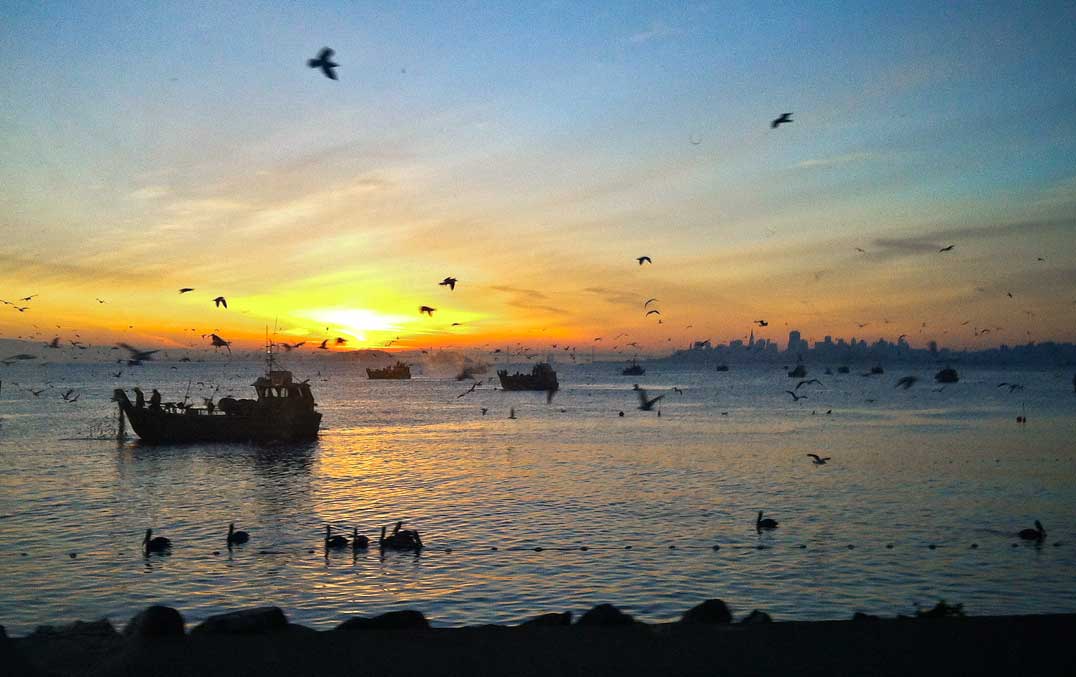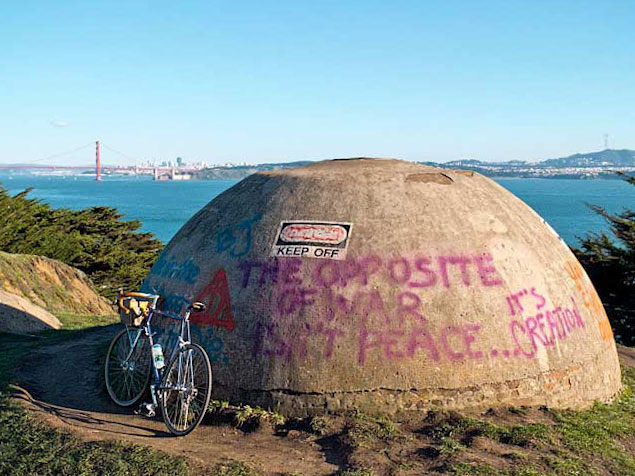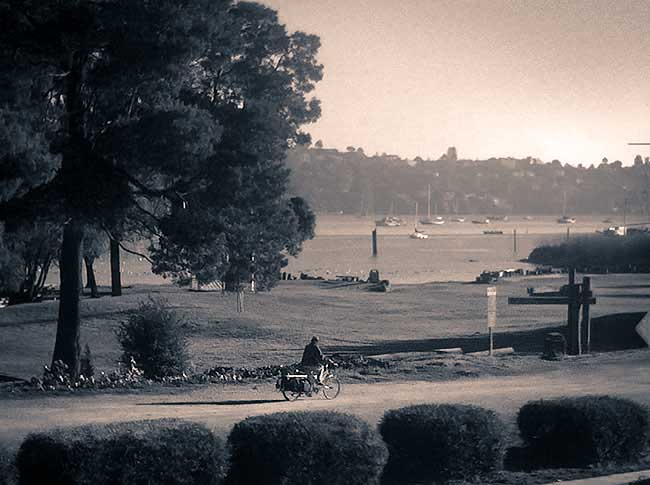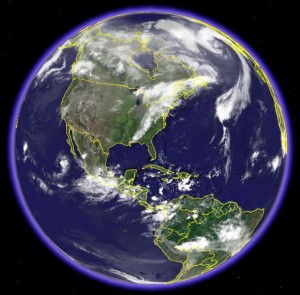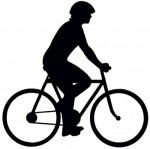On the Road……Tennessee Valley Rd. to the Pacific Ocean
These are a few photos from a ride out to the Pacific Ocean via Tennessee Valley Rd. The post from bike to work day shows my turn around point on the sandy beach off on the horizon.
The road is rough — and super steep — in a few places. The only other bikes out here were mountain bikes like the one above.
But the Ebisu soldiered on…
Biking Culture……The New Yorker bicycle covers, Part III
I’ve said it before: I think The New Yorker has a thing for bicycles (see Part I and Part II in this series of posts)
This time, with the introduction of NYC’s bicycle share program, the storied literary magazine has a genuinely newsworthy reason to feature bicycles on their cover.
There was also this cover from back in February.
Can you count all the hipster tropes?
- thick-framed eyewear
- food truck
- body ink
- beard
- knit cap
- duffle coat w/ toggles
- discriminating (if not condescending) gaze
- Brooklyn residence
Did I miss anything?
On the Road……Redwood Grove: 4 years later
On a recent ride in the hills above Fairfax I passed this spot.
There’s a natural drainage running along this north facing slop, which Bolinas-Fairfax Rd. bisects. It’s cool and moist and there’s a stand of redwood trees.
This is also the spot where I made my very first photograph for this site almost 4 years ago to the day!
Here’s a link to the photograph and post #1.
And here I am, 4 years later writing post #448.
I wonder where I’ll be 4 years from now?
On the Road……A Poem – on Bike to Work Day
In the dream,
we till the loamy soil
and work the byways and flyways
of pacific salmon
and monarch butterflies.
Days flow like cycling migration patterns of hummingbirds and
humpback whales.
— nourished by seal pup carrion and wildflowers.
Lew is right. There is no place else to go,
but remember that rascal Chuang Tzu.
Waking up he says,
“Maybe my life is only a butterfly’s dream.”
-Nathan, May 9, 2013
On the Road……Coastal Sunset & Digital Metering w/ Sony RX100
Here’s the sunset at 8:04pm from Thursday’s ride in the Marin Headlands.
The light was tricky. It was well into twilight, and there was a sharp contrast between the lightest and darkest areas in the scene.
(Note: roll your mouse over the image to see the extreme difference in the unprocessed camera file.)
For a landscape scene like this a serious photographer would typically use a large-sensor DSLR camera plus:
- a tripod (to allow for a long exposure to let in more light without introducing blur from inadvertent camera movements) and
- a graduated neutral-density filter (to control the scene’s dynamic range by reducing the brightness of the sky — but not the foreground).
However, my little Sony RX100 (reviewed here by NY Times tech writer David Pogue) handled the scene fairly well.
Here is the processing technique I recommend for this — or really any — digital photograph:
- Choose an exposure that preserves the brightest areas in the scene. That is, “expose for the highlights” to retain the vivid color and detail which might otherwise get “blown out”. Metering the scene like this will render the rest of the image too dark, but that’s okay. When mousing over the above image, you can see how everything — except the sky, the bike’s shiny metal parts, and the clear water bottle — is way (and I mean way) underexposed.
- Tweak the shadow areas in post-processing according to taste. Here is where we adjust areas that are too dark. When I opened-up the shadow areas in Photoshop using a curves adjustment layer there was surprisingly still enough detail hidden in the file to create a decent image (at least for viewing on the web). In most images the before/after differences will be less extreme, but the technique will be the same.
By the way, this is the exact opposite of what Ansel Adams did in his black and white film photography. He would “expose for the shadows“, that is, meter the darkest area of the scene to preserve wanted detail, then in the darkroom develop the highlights to taste.
The difference in technique is a function of how digital sensors and film emulsions handle highlight rendering. For a good discussion of Adams’ technique and his Zone System, see this article.
-Nathan
On the Road……Sunset over the San Francisco Bay
April-May and Sept-Oct can always be counted on for balmy weather in the Bay Area. Today, it was 80+ degrees in downtown San Francisco!
The wind was gusting a bit in Sausalito when I arrived home from work, but around 7pm the wind just stopped.
Even at this hour the air was still warm. So I couldn’t resist a short climb up to the Golden Gate Bridge and then further up into the Marin Headlands to watch the sunset.
Even on the long descent coming home (as it was getting dark) I was completely comfortable in just a short-sleeve, cotton t-shirt.
These pictures were made at 7:53pm.
It’s not fair to extrapolate anything from a single picture, but it’s kind of funny that the guy is checking his phone, while the girl is totally digging the moment.
I’m not casting judgement because I’ve been that dude — maybe we all have.
On the Road……Crunching the numbers: Cars vs. Bikes
My Honda Fit needed some repairs (valve adjustment, transmission fluid and oil change, tire rotation, driver side mirror wiring harness, and visor clip) so I had to figure out how to get to and from the dealership twice this past week.
I decided the most efficient solution was to drive to the Honda shop after work and bring my bicycle along. Then I could drop off my car and use the bike as transportation to get back home. When my car was ready for pick-up later in the week, I would repeat this in reverse, i.e., ride my bike back to the dealership, then drive the car and bicycle back home together.
Since I would be making essentially the same trip by both car and bike several times I jotted down some numbers:
- by car it was a 9.1 mile one-way trip (mostly on highway 101) and took me all of 13 minutes.
- by bicycle it was a 10.6 mile one-way trip (mostly on bike paths and back roads) and took me 46 minutes.
Adjusting for the mileage difference, the bike ride was almost exactly three times less efficient in getting me from point A to point B. But it’s probably more accurate to just say the bicycle was three times more time consuming.
Examining the bike’s efficiency (in isolation) is problematic. One can argue that all the time and energy spent riding the bike should count against the car. If one expands the boundary conditions of this hypothetical efficiency equation, you realize my bicycle riding was only necessary because of the needed automotive repairs!
However, in the process of bicycling this route twice in one week, I enjoyed myself quite a bit, got some needed post-work exercise, and became more acquainted with Marin bike paths and the new bicycle and pedestrian tunnel that opened last year, connecting Larkspur and San Rafael.
So what now? Do I register this joy and satisfaction on the bike’s or the automobile’s side of the ledger?
Now I’m really confused.
Anyhow, the picture above is in Mill Valley. Gotta love the classic VW bus.
Off Topic……Two films about birding
The Central Park Effect.
This quote from the film (starting at 1:01 on the video clip below) addresses a frequent stereotype aimed at those who enjoy this pastime.
“There’s really no way to look cool. You’ve got your binoculars up. You’re looking at something that nobody else is looking at. And everyone else is looking at you and thinking, you know, ‘what a dweeb’.”
The Big Year. It got poor reviews, but I really loved it. (I hear most real birders hated it).
On the Road……Pt. Reyes Birding and Nature Festival
The 4th annual Pt. Reyes Birding and Nature Festival is going on this weekend.
As a novice birder, I settled on a beginner’s 3-hour bird walk through the meadows and forests near the Pt. Reyes visitor center off of Bear Valley Road. Rich Cimino, with 45-years of birding experience, lead the walk. (Rich also runs a company, Yellowbilled Birding, specializing in small group, birding trips, in the western US.)
The most exciting sightings for me were the Purple Finch and Winter Wren. The latter has one of the most complex songs of any bird (listen on this page). The Winter Wren can be quite elusive and difficult to spot. Rich said it takes some California birders many years before they see one!
Here’s my list of the birds I spotted:
- California Quail
- Turkey Vulture
- Red-tailed Hawk
- Acorn Woodpecker
- Nuttall’s Woodpecker
- Great Horned Owl (heard, not seen)
- Stellar’s Jay
- Western Scrub Jay
- American Crow
- Common Raven
- Violet-green Swallow
- Winter Wren
- American Robin
- Wilson’s Warbler (heard, not seen)
- Purple Finch
The previous day’s schedule had a workshop called Birding by Bike at Bolinas. Here’s an excerpt from the on-line class description.
Whether you are a beginning birder or have been at it for decades, bicycling adds a whole new dimension to the pursuit and study of birds…Bolinas has a rich diversity of habitats and there is no better way to experience those qualities than by bicycle. As we move through the landscape we will be birding by ear, listening for the voices of returning migrant breeding and resident species alike…With so many habitats all mashed together, participants will take advantage of the opportunity to visit at least seven distinct habitat types and learn a bit about the plant communities therein. Being the height of spring, bird birdsong and bird detectability will be at their peak. As it happens, bird diversity is also at its spring peak during this period. The group will make frequent stops on our “migration” to search out as many species as possible.
I’m not completely on-board with mixing these two activities. I feel the same about SUP yoga — each one (yoga and stand-up paddle-boarding) already seems whole and complete on its own. Combining the two risks lessening the other, don’t you think?
Gear Gallery……The Grand Bois Lierre
I finally upgraded my tires from the Panaracer Col de la Vie to these: the Grand Bois Lierre.
You may not think 2mm makes much of a difference, but on my first ride the 38mm-wide Lierre felt much cushier and seemed to move more effortlessly over broken, chipped pavement than my old 36mm-wide Col de la Vie tires did.
So if you have 650B-sized wheels — this upgrade is a no-brainer.
Of course, if my bike could fit them, I would love to be riding the even cushier (but still fast) 42mm-wide Grand Bois Hetre. The brownish-red tread is very cool (downright sexy some would say — if it’s possible for a bicycle tire to be sexy.)
On the Road……One more from Rodeo Lagoon
Here’s one more image taken by Rodeo Lagoon. This was my first time riding on a new set of Grand Bois tires (I’ll write more about these tires later).
On a side note: I’m so grateful to be living in a place as beautiful as the Bay Area. I hope I don’t ever take living here for granted.
Random Images……Cala lilies on Highway 1
In light of yesterday’s post, here’s some calla lilies (Zantedeschia aethiopica) that I photographed several weeks ago growing along Highway 1 in Marshall, CA.
On the Road……Fort Cronkite calla lilies
I find the calla lily (Zantedeschia aethiopica) a very elegant and photogenic specimen. They’re native to southern Africa, but have made their way around the world to places such as California and Australia. Australia classifies them as pests and toxic weeds. Hey Australia, that’s no way to treat a visitor!
This bunch of lilies is growing against one of the old, military buildings in Fort Baker. (Note the red-roof: it’s a signature architectural feature of the structures inside this park).
On the Road……Coastal Trail near Rodeo Beach
Sometimes when you’re exploring by bicycle you discover little things you never noticed before. On Saturday, I discovered this section of the Coastal Trail.
On the Road……Late Saturday afternoon at Rodeo Beach
The wind settled down for my ride home, but approaching Rodeo Beach it was gusty!
This body of water is Rodeo Lagoon and on the other side of that massive sand bar is the Pacific Ocean. For the most part, the two bodies remain separate. But on occasion (usually in winter) tidal storm surges let in ocean water, which keeps the lagoon rather brackish.
This “lake” is a productive ecosystem that supports endangered species like the brown pelican and a family of river otters that feed on them!
Check out this graphic that details: How otters take down pelicans.
Gear Gallery……Having it all? Versatillity, speed, and sprightliness
Is it sacrilege (or fickleness) to doubt my relationship toward my two primary bicycles: the Guerciotti and the Ebisu because each has something the other lacks?
I made some tweaks to my Guerciotti’s set-up about seven years ago and ever since I’ve been pretending it’s a randonneuring-style bike and the truth is it’s really not. The Guerciotti is a racing bike with classic Italian geometry. It doesn’t hold a front handlebar bag that well and although I’ve shoe-horned 28-29mm wide Grand Bois tires onto it, the bike’s narrow clearances will not except fenders.
The bottom line: it’s fast and really fun to ride, although a bit twitchy like an Alfa Romeo.
But most importantly the bike’s super light tubing allows it to “plane” — an elusive (some say phantom) sensation whereby the frame’s flexibility works in a sort of mysterious, mechanical harmony with the rider. Jan Heine, the publisher of Bicycle Quarterly, coined the term “planing” as it pertains to bicycle performance and has written about these subjects extensively.
My Ebisu, on the other hand, was purposely built to carry a loaded handlebar bag (it can even be set up with front panniers for a short tour) along with wide tires (up to 38mm wide) and fenders. But if I’m honest, the Ebisu is not quite as responsive and fun as my Italian racing bike. Continuing the car analogy, if the Guerciotti is an Alfa, the Ebisu is a Subaru Forrester.
So what are the underlying causes of these differences? I’ve pinpointed two:
- Responsive shifts: the 9-speed cassette on the Ebisu makes manual friction shifting a fine, delicate operation. On the other hand, the Guerciotti drivetrain is based around a more direct, positive feeling, 6-speed freewheel. The difference is significant.
- Planing: my Ebisu frame feels stiffer than the Guerciottti and it does not noticeably plane while riding. Understandably so. The Ebisu was constructed by master builder Hiroshi Iimura as more of an all-around bike capable of mid-to-light weight touring. But I do miss the feeling of riding my racing bike when I ride something else. The joy of pedaling hard and covering varied terrain is related — at least for me — to the stiffness of a bicycle’s frame.
It took time, but I discovered my preference for a more flexible frame through trial and error after pedaling different kinds of frames many miles over northern California’s hilly roads (and from reading Jan Heine’s articles in Bicycle Quarterly).
My Ebisu is perfectly designed for its purpose and performs more the way I like when it’s carrying extra weight. It seems that the additional weight (since I’m only 150-55 lbs.) causes the Ebisu frame to flex more than normal thus making the frame more responsive and lively when fully-loaded (as opposed to when it is ridden un-loaded).
Where does this leave me?
It means I need to find a bike close in design to the Ebisu, but with light, flexible, tubing like the Guerciotti. The only question is whether to base it around a 700cc 32mm tire or the highly-reviewed 650B 42mm Hetre tire?
Below are some images of bikes and makers which include the option of using super lightweight tubing in their designs.
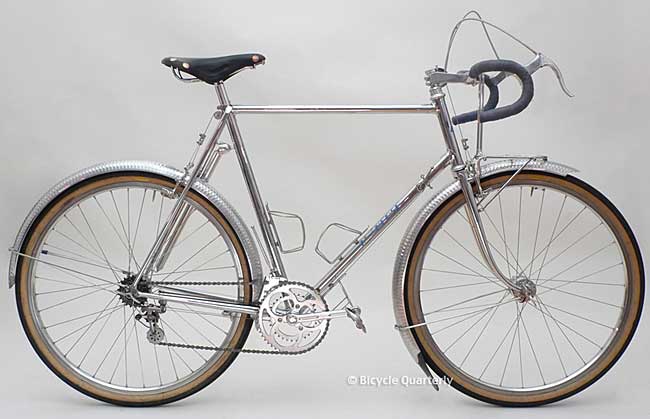 Jan Heine’s custom Rene Herse
Jan Heine’s custom Rene Herse  MAP bicycle in 700cc wheel size
MAP bicycle in 700cc wheel size
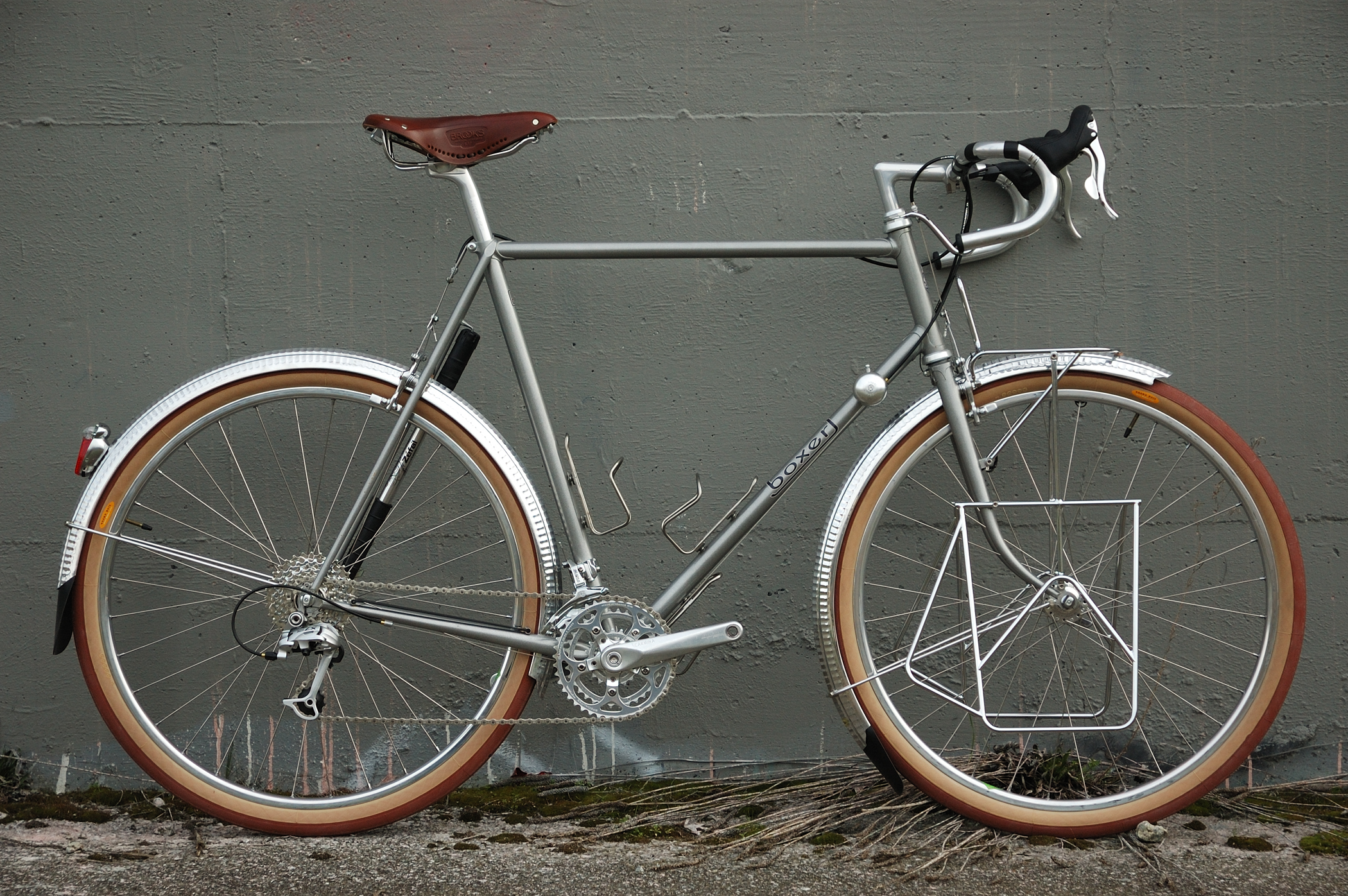 Boxer Bicycles
Boxer Bicycles 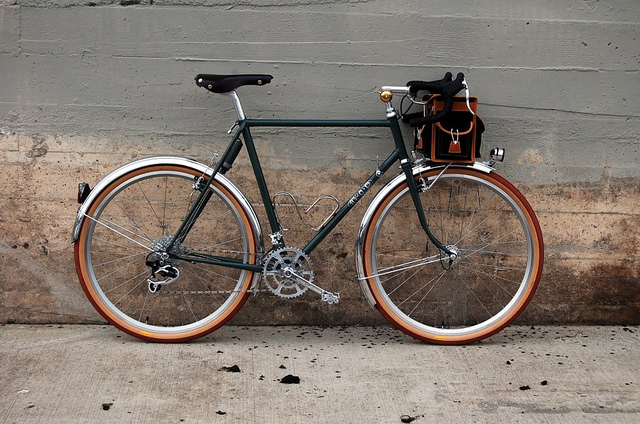 MAP bicycle in 650B wheel size
MAP bicycle in 650B wheel size
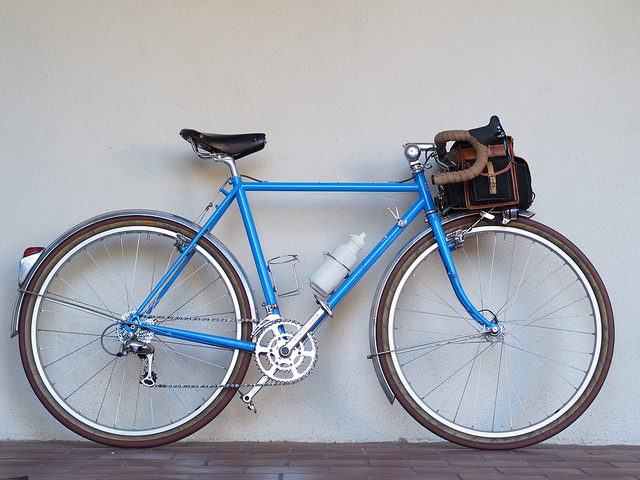 Box Dog’s Pelican (a local Bay Area company).
Box Dog’s Pelican (a local Bay Area company).
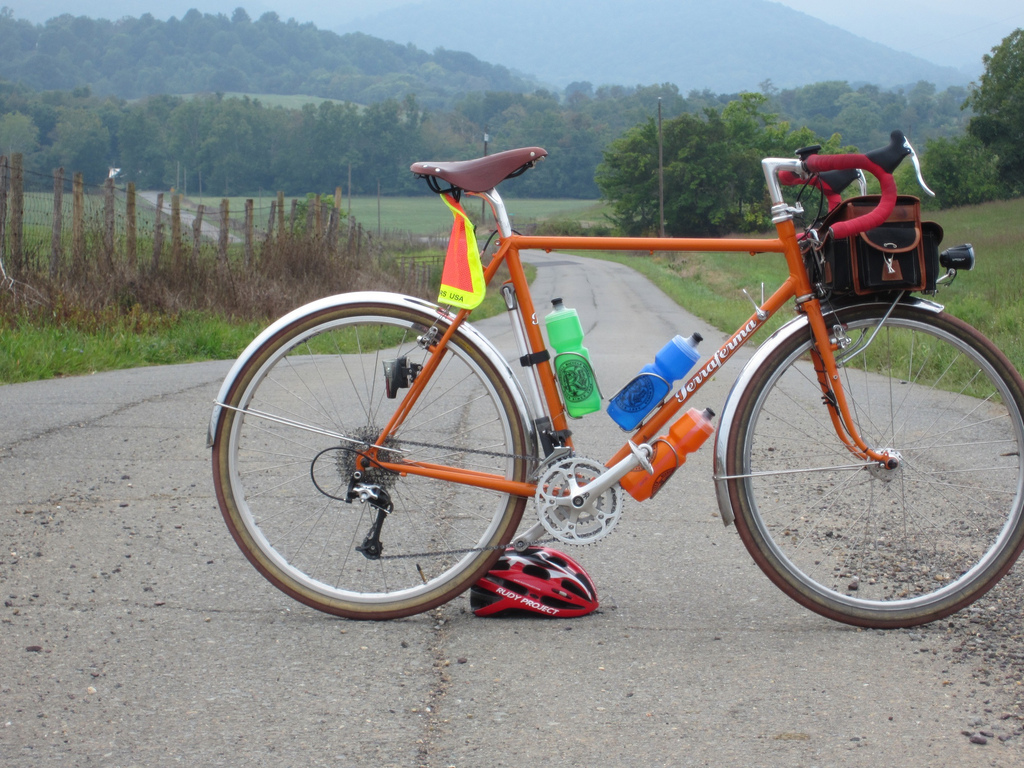 Terraferma Cycles (courtesy chasingmailboxes)
Terraferma Cycles (courtesy chasingmailboxes)
On the Road……A sandy beach near downtown Sausalito
This little sandy beach is within easy walking distance from my place in Sausalito.
Here you can rent SUPs (i.e. stand-up paddle boards) or a sea kayak or just kick-back on the sand. La Garage the french bistro is nearby too.
That’s appropriate because this view — with the sunshine and yachts — made me think of Marseilles or Saint Tropez; Jean-Luc Goddard; and French Ye-ye music such as this song by Francoise Hardy (which was prominently featured in Wes Anderson’s film Moonrise Kingdom).
On the Road……The Life Aquatic: Marshall, CA
If people ask me my favorite town in Marin County, I answer Marshall.
I do it for the puzzled look I inevitably get since few people have heard of the little community that has a population somewhere between 50 and 400.
My second favorite? Dogtown, with a population of 30.
On the Road……Tomales Bay, Marshall CA
The Marshall Store — one of many spots on the east side of Tomales Bay to stop for fresh oysters.
If you like shucking the oysters yourself, you should visit the Tomales Bay Oyster Co., Hog Island or Drakes Bay Oyster Co. (which continues to fight the Park Services’ decision prohibiting them from renewing their commercial lease to farm oysters in a nationally designated wilderness area).
Random Images……Black Brompton at the SFMOMA
I spotted this Brompton in front of the SFMOMA. The image was made near the museum’s entrance while facing 3rd Street around 5pm. The bike belongs to Sunny (from the comments section of this post).
Photographing a black bike is challenging, especially in patchy, bright sunlight. But I like how this picture turned out. The orange taxi pleases me a great deal.
The only problem is you can’t really see how good-looking this bike is (I especially like the generator-powered headlight and Brooks saddle).
Sunny purchased his bike from the same dealer in Palo Alto as I did, which, according to the website, is the first authorized Brompton retailer in the US. The shop operates out of the palatial home of Mr. Channell Wasson. Channell is an interesting character and a truly passionate Brompton enthusiast.
-Nathan
On the Road……Toward Pt. Reyes on Sir Francis Drake
Finally, finally, finally, part of Sir Francis Drake Blvd. heading out to Pt. Reyes Station and Tomales Bay has been resurfaced.
This was one of the most scarred, chipped, and potholed roads in Marin. I always pedaled on the Lagunitas bike path because it’s more scenic, but a road in this condition (even without bike lanes) is tempting!
Note: the resurfacing isn’t complete. There’s still several miles of really bad, beat-up road that resumes just before Devil’s Gulch if you’re traveling west.
Random Images……Vermeer sighting at the de Young
As promised, a few observations about the Dutch paintings exhibit currently on view at the de Young Museum.
Here are my six takeaways:
- The light from within. When I walked into the opening room of the exhibit I gasped — audibly — shocked by the sensory perceptions and emotions that flooded in as I first cast my eyes on the landscape paintings that radiated an inner glow. The light from within these paintings was so palpable I actually began to question my own experience, rationalizing that the museum’s sophisticated lighting had something to do with it.
- Presentation matters. The de Young did a superb job with the the overall design and display of the exhibit. How the paintings were arranged, the size and flow of the rooms, and even the space between paintings and their height from the floor, all seemed perfect. I’ve seen Vermeer paintings at the Metropolitan Museum in NY and Vermeer paintings at the National Gallery in Washington, DC. This kind of art has never looked as good as it does here in San Francisco.
- I prefer “old” art to “modern” art. A huge generalization, but so much of modern art seems designed to provoke or to extol things like irony, cynicism, and even ugliness. Yet these paintings inspired and uplifted me and that is the best justification for art in my opinion.
- My appreciation grows with age. My capacity to appreciate and be affected by this kind of art has truly deepened over time. My life experiences and accumulated wisdom (at least what there is of it) allows me to see and feel deeper than I could when I was in my 20s, for instance. This may not be anything revelatory, but it was a big takeaway for me.
- On masterpieces. Is there such a thing? Are they overrated? Some of the “greatest hits” from the masters are now devalued cliches. Derivatives and crude, poorly reproduced facsimiles show up in pop culture, in digital media, or on billboards. So I stood in front the actual physical object of Girl with a pearl earring looking for a long time to decide for myself if it is, indeed, a masterpiece. The answer: Yes it is. By the way, so too is Rembrandt’s Portrait of an elderly man, which is also part of the show.
- Fewer is better. I prefer small exhibits to large exhibits, and this is a relatively small exhibit. In fact, a long time ago I stumbled upon a useful practice after spending many grueling hours at the Louvre in Paris. This simple principal has guided me ever since: Never spend more than 45 minutes in a museum, 30 minutes would be even better. It’s much more satisfying to look intensely for 30 minutes, rather than to look superficially for 1-2 hours. That’s my advice. Plus, you can always return another day. Return I will because I didn’t have time to see all Rembrandt’s pencil drawings and etchings.
I don’t know why, but I went in with low expectations and, instead, came away pleasantly surprised.
Overall rating: Five stars!
The show runs through June 2nd.
-Nathan
On the Road……Brompton front Basket in Sausalito
When I bought my folding bike I knew it had to have some handlebar luggage. In the end, I settled for a simple, folding basket.
The basket is big — it holds a lot more than one would think. I’ve over-stuffed it with a large, heavy, travel backpack (as you can see here, here, and here) and it handled the load quite well.
What’s unusual about the Brompton design is that the basket doesn’t track the movement of the handlebars and front wheel — rather it’s always aligned with the frame and rear wheel. In other words, the basket always faces straight ahead even when you turn the handlebars side-to-side.
This is disorienting at first, but something you quickly become used to.
In the images above and below, the basket carries a full shopping bag of laundry on the way to the cleaners.
Gear Gallery……The Vintage Bicycle Print Pocket Square
The ascot, neckerchief, and pocket square: These are the third rail of men’s clothing.
Wear them at your own risk and prepare to suffer the consequences — ridicule from your guy friends and, bemused, emasculating laughter from the girls.
Despite all the risks, I’m considering integrating a pocket square into my wardrobe lineup.
I probably wouldn’t choose this one (it crosses over into the foppish category, at least to my eye), but it is in stock on the Unionmade website. Drake’s — a venerable English clothier is the maker.
-Nathan
On the Road……Golden Gate Park Bike Rack
The bike rack in front of the de Young Museum is much happier than this lonely bike rack. Note that Sutro Tower is visible in both photographs (obviously in this photo; less so in the linked image).
I made this before viewing the Girl with the Pearl Earring exhibit at the de Young.
To find out what all the fuss is about (or at least my take on Vermeer and the Dutch Masters) stay tuned.
-Nathan
On the Road……Plum Blossoms (Ume) in Golden Gate Park
The cherry plum blossoms around the Bay Area are in peak bloom — or that’s how it looks to me after watching them for the last 2-3 weeks!
In Japan, the plum blossom has been overtaken in popularity by the similar looking cherry blossom. In case you’re curious, the Japanese word for cherry blossom is Sakura; for plum blossom it is Ume. Both are members of the genus Prunas.
It’s common to celebrate blossom time with festive picnics (and sake drinking) under the beautiful flowering trees.
Here’s an excerpt from wikipedia’s cherry blossom article:
In Japan, cherry blossoms…symbolize clouds due to their nature of blooming en masse, besides being an enduring metaphor for the ephemeral nature of life, an aspect of Japanese cultural tradition that is often associated with Buddhistic influence, and which is embodied in the concept of mono no aware. The association of the cherry blossom with mono no aware dates back to 18th-century scholar Motoori Norinaga. The transience of the blossoms, the extreme beauty and quick death, has often been associated with mortality; for this reason, cherry blossoms are richly symbolic, and have been utilized often in Japanese art, manga, anime, and film…
-Nathan
On the Road……Sausalito Ferry Terminal
The line of bicyclists waiting to board the 6:10pm ferry to San Francisco stretched down the pier, around the parking lot, and then back-up Bridgeway Blvd.
These cylotourists (most of whom rented their bikes from operators in the Fisherman’s wharf area) bicycled across the Golden Gate Bridge to Sausalito, and are now taking the ferry back to the city.
This page has everything you need to know about biking (as a tourist) from SF to Sausalito. And here’s the Golden Gate Ferry, Bikes and Ferries page.
-Nathan
On the Road……Downtown Sausalito’s Seal Statue at Twilight
About 8 minutes before sunset, on February 16, 2013, nearing civil twilight. (For more details on twilight — civil, nautical, and astronomical, see one of my favorite posts on this blog.)
Under challenging conditions, this is the best I can get from my iPhone (by the way, those are birds in the sky; not dust specks on the lens).
For an exquisite interpretation of this subject, check out this local photographer’s image of the Sausalito seal — la composition par excellence!
-Nathan
On the Road……Downtown Sausalito’s Seal Statue
I have a love/hate relationship with the iPhone’s camera.
This twilight photo made over the weekend seriously stresses its photographic limits and although the camera is often good enough, it has two big flaws:
- Image quality: it cannot handle wide dynamic range and low-light conditions very well.
- Handling: it is slow to start up, clunky, and ergonomically infuriating.
Nonetheless, the old cliche still applies: “The best camera is the one that you have with you.”
And I almost always have the iPhone with me.
Still, for me, it’s a highly unsatisfying photographic tool. And, the tools we use in our daily lives — the quality of their craftsmanship and their aesthetics — are important. Right?
I recently sold two older digital cameras on eBay so I’m allowing myself to look at new cameras again. The highly touted Sony RX100 is a pocketable camera, but with image quality, resolution, and low light capabilities that vastly outperforms every other small-sized camera on the market.
Unfortunately, the Sony still does nothing for me from an aesthetic standpoint. It has few manual controls and no viewfinder, for instance. So it really only solves half the problem presented by the iPhone’s camera — i.e. vastly improved image quality. It does not fully address the handling issue.
If only an aesthetically pleasing, elegant, and functionally designed camera body like the Olympus XZ-2 or Fuji X10 could be married to Sony’s wonderful, large sensor.
That combination would be a truly satisfying photographic tool!
-Nathan
On the Road……Amsterdam-style Bike Sighting
Here’s an Americanized version of a classic Dutch bicycle (the Amsterdam manufactured by Electra) spotted at the Sausalito Herring Festival on Sunday.
I like the chain guard and the front wicker basket. I really, really dig the rear pannier bags. These are the real deal — a Dutch company called Basil makes them.
But overall, I think I prefer Electra’s Ticino model over the Amsterdam. I just don’t care for the almost gooseneck-like curve of the frame’s top tube.
If you’re going to get a Dutch bike I like the Jorg & Olif, which I featured in this post.
On the Road……Sausalito’s 1st Annual Herring Festival
I rode my Brompton down the street to meet some friends at the 1st annual Herring Festival, but I couldn’t believe they ran out of all their herring by 1pm!
I did manage to sample the grilled herring on a skewer and the pickled herring (I preferred the pickled herring).
One of my favorite places to eat in Sausalito, Fish, was on hand, as were others, to help raise funds for one of the town’s community boating centers, Cass Gidley Marina.
During the afternoon, I also spoke with a CA fisheries biologist who filled me in on this local, commercial fishery — it seems we have at our doorstep a truly sustainable fishery. The season started in January and is open through mid-March. Last year’s catch was more than 1,600 tons of fish.
Interestingly, the primary product is the herring roe, which is sold to the Japanese. In Japan, herring roe is called Kazunoko.
I was excited to learn all this because in recent weeks I’ve been seeing awesome displays of bird life (and a few sea otters looking fat and content) out in the harbor. I captured a bit of this spectacle in this photograph.
Now I know what all the fuss was about — the little Pacific herring (Clupea pallasii).
On the Road……Near GGNRA’s Coastal Trail: Marin Headlands
Riding east on Bunker Rd. I found this picaresque spot, made even more so by the recent rain which created a mini-wetland.
It’s directly off the main road, but also at the end of a fork that connects to the Coastal Trail (used for hiking and mountain biking), which leads up the ridge to the traffic circle on Conzelman Rd. or (if followed in the other direction) down to the beach at Rodeo Cove.
The Coastal Trail eventually reaches Fort Cronkite, which houses an eclectic group of organizations including the Headlands Center for the Arts, Foundation for Deep Ecology, and The Marine Mammal Center.
Gear Gallery……1972 Schwinn Paramount in full Chrome
This is Harry. I bumped into him at the tail-end end of the Marin Civic Center Farmer’s Market on Super Bowl Sunday. His chrome-plated 1972 Schwinn Paramount jumped out me like the organic strawberries my friends had scored earlier. I asked him to pose with his 1972 Paramount next to a nearby 1972 VW beetle.
The Brooks saddle has a well-worn patina from years of use. The components look mostly (if not all) original including a Campagnola Nuovo Record groupo.
The Nervez lugs look beautiful in full chrome.
On the Road……”Wintertime” ride to Alpine Lake in Fairfax
Last week-end, I packed a light lunch and took one of my favorite rides out to Alpine Lake in Fairfax.
The sun was bright and strong, but it was still very cool in the shade. So I wore a pair of wool knickers and two cotton t-shirts (one long-sleeve and one short-sleeve), which was perfect.
During the long downhill stretches — through the redwood groves where the cold air tends to chill you to the bone — I put on a light wind jacket. On cold days, I always keep an inexpensive one stuffed in my handlebar bag. Mine is a basic, clear plastic, no thrills jacket that cost less than $20, but is the difference between freezing on long descents or being comfortably warm.
As it turned out, the long-sleeve wool layer (that I forgot at home) wasn’t even necessary.
These sunny, Northern California winter days are glorious!
-Nathan
On the Road……Light lunch at Alpine Lake in Fairfax
Lunch packed in a musette bag. (That little Japanese knife has been to Alpine Lake before.)
On the Road……Pt. Bonita Bike Rack
The loneliest bike rack.
But an important one if you ride out here and want to visit the lighthouse.
Make sure to bring a lock.
On the Road……Pt. Bonita Lighhouse entrance
Rust-colored moss, bright green plants, and a churning light azure, icey blue sea — a collage of color at the entrance to the Pt. Bonita lighthouse.
Unfortunately, I arrived 8 minutes after closing time (and couldn’t get into the actual lighthouse or up onto the high point of the rocks and the viewing platform).
To add further insult, the park ranger scolded me for showing up at the bottom of the paved, 10-foot wide, 1/4-mile path with a bicycle — even though I walked it all the way down.
Apparently this is a no-bicycle zone (not a “no-bicycle-riding” zone — simply “no bicycles” period), which makes this picture of me that much more scandalous!
-Nathan
Random Images……Sausalito morning commute
A quick snapshot through the window of Golden Gate Transit’s #2 bus at approximately 7:20am.
It looks like something from Hitchcock’s The Birds – which incidentally was filmed locally in nearby Bodega Bay.
On the Road……Above Bonita Cove: Views of the Bridge and Sutro Tower
I’m not exactly sure what this graffiti artist is trying to communicate. Perhaps, it’s that war = destruction? (since the opposite of creation is destruction).
But speaking of language, the December 24th issue of The New Yorker magazine had a curious article by Joshua Foer about an amateur linguist named John Quijada. When he wasn’t working at the Department of Motor Vehicles, Quijada spent his spare time (extending over 25 years) engineering a new language and grammar system combining what he believed were the best aspects of all the world’s languages.
Here’s a quote from the beginning of the article:
In his preface, Quijada wrote that his “greater goal” was “to attempt the creation of what human beings, left to their own devices, would never create naturally, but rather only by conscious intellectual effort: an idealized language whose aim is the highest possible degree of logic, efficiency, detail, and accuracy in cognitive expression via spoken human language, while minimizing the ambiguity, vagueness, illogic, redundancy, polysemy (multiple meanings) and overall arbitrariness that is seemingly ubiquitous in natural human language.”
Ithkuil has two seemingly incompatible ambitions: to be maximally precise but also maximally concise, capable of capturing nearly every thought that a human being could have while doing so in as few sounds as possible. Ideas that could be expressed only as a clunky circumlocution in English can be collapsed into a single word in Ithkuil. A sentence like “On the contrary, I think it may turn out that this rugged mountain range trails off at some point” becomes simply “Tram-m?öi hhâsma?p?uktôx.”
This is really quite odd.
Ithkuil seems to be a language devoid of nuance, implication, metaphor, and for that matter: poetry!
Random Image……Cargo Bike at Dunphy Park, addendum
As a follow-up to the previous post, here’s one final traditional B&W darkroom variation called a duotone (For an in-depth, but slightly outdated photoshop tutorial and explanation of dutones see this article on the Luminous Landscape website.)
The highlights (i.e. the brightest areas of the tonal range) receive the sepia tint and the shadows (the darkest areas) receive the blue tint.
Actually, this may be my favorite version so far.
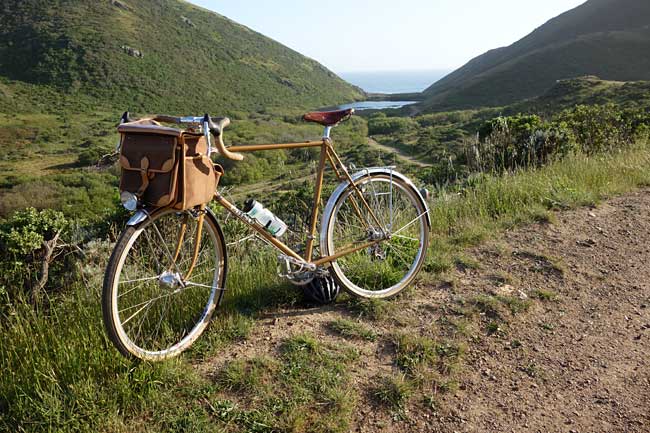
 Show on map
Show on map
